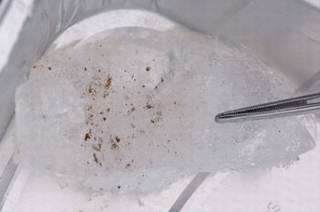Frozen Microbes Reveal How To Test For Martian Life

"We tested equipment that we are developing to look for life on Mars and discovered a rare and complex microbial community living in blue ice vents inside a frozen volcano," remarked Hans E.F. Amundsen of Physics of Geological Processes (PGP) at the University of Oslo, Norway, and leader of the international AMASE team.
Image: Trapped mineral fragments associated with microbial communities appear inside blue ice. Photo: Kjell Ove Storvik/AMASE
AMASE, the Arctic Mars Analog Svalbard Expedition, is designing devices and techniques to find life on Mars. Their test ground is Svalbard, (Norway) an area with a geology that is analogous to some Martian geology.
"The instruments detected both living and fossilized organisms, which is the kind of evidence we'd be searching for on the Red Planet," he continued. The AMASE expedition will be featured on Norwegian TV on October 6.
Science leader of AMASE, Andrew Steele of the Carnegie Institution's Geophysical Laboratory, explained that "ice-filled volcanic vents, such as these, are likely to occur on Mars and may be a potential habitat for life there."
The carbonate rocks found within the approximately 1-million-year-old Sverrefjell volcano on Svalbard are similar to carbonate rosettes found in the Martian meteorite ALH84001 and may have been produced by common processes. The blue ice, trapped in the volcanic vents, may represent samples of water that formed identical carbonate deposits in the Sverrefjell volcano.
The scientists detected living and fossilized microbiota, in the ice and on the surfaces and cracks of other volcanic rocks, using their integrated life-detection strategy successfully tested by AMASE in 2004. "Our instrument, designed by scientists at the Jet Propulsion Lab (JPL), detected minute quantities of aromatic hydrocarbons from microorganisms and lichens present in the rocks and ice," said Arthur Lonne Lane of JPL who made his 2nd voyage with the AMASE team.
Steele's team from Carnegie deployed a suite of instruments to detect and characterize low levels of microbiota. "We performed several successful tests with a miniaturized instrument fitted with special protein microarray chips," says Steele. "Our results showed that we were able to maintain sterile sampling procedures without introducing contamination from humans."
Coring of the blue-ice vents and surface glacial ice involved developing a detailed procedure for sterilization of the ice-coring tool. "The organisms found in ice are survivors! Small ecosystems in the ice have apparently adapted to extremely cold conditions," says Liane Benning, University of Leeds. The ice and rock samples will be characterized further in labs at the Carnegie, the Smithsonian Institution, PGP, Penn State, and University of Leeds.
This summer's AMASE expedition also involved interdisciplinary studies of the world's northern-most thermal springs above sea level, rock weathering and pattern formation, and biota in glacial ice by the physicists, geologists, chemists, and biologists on the team.
The AMASE group sampled sedimentary rocks that are roughly 780 million-year-old, which contain remarkable remains of microbial structures that still maintained morphologic structure.
"These rocks hold potential chemical markers of fossilized life. If there is similar evidence in ancient rocks on Mars, our equipment will be able to find it," says Marilyn Fogel, biogeochemist and astrobiologist at Carnegie.
The Arctic Mars Analog Svalbard Expedition (AMASE 2005) team comes from the following institutions: Physics of Geological Processes, University of Oslo; The Carnegie Institution of Washington, Geophysical Laboratory and Department of Terrestrial Magnetism; NASA Jet Propulsion Laboratory; University of Leeds; University of Oxford; Universidad de Burgos, Spain; The Smithsonian Institution; Penn State University; Geological Institute, University of Oslo and Idaho National Laboratory. The expedition photographer was Kjell Ove Storvik and expedition artist was Eamonn Shaw. AMASE 2005 included reporters from Die Zeit and Norwegian radio (NRK P2) and a film crew from Norwegian television (NRK1-Schrödingers Katt).
Copyright 2005 by Space Daily, Distributed United Press International















